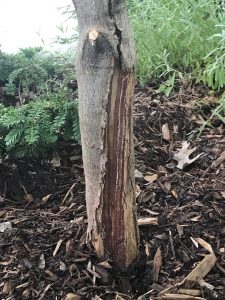
I have a beautiful Japanese maple with a trunk that is split on the north side, perhaps due to winter freeze-thaw. The tree still appears healthy, but I am concerned about this and am wondering if there is anything I can do to help the tree beyond its good soil, mulch and irrigation? Is there something I can do before calling in an arborist?
Thank you for contacting the Toronto Master Gardeners with your query concerning your Japanese Maple.
We receive numerous questions concerning ailing Japanese maples. The following are from two of our archived posts:
“This past winter, in southern Ontario, was particularly harsh, not so much due to heavy snowfall, but more so due to several thaws, follow by an immediate return to the deep freeze. This can often cause tree trunks to split.
Trees respond to wounding or injury by forming specialized “callus” tissue around the edges of the wound. Thus, the tree responds to the injury by “compartmentalizing” or isolating the older, injured tissue with the gradual growth of new, healthy tissue. Not only do trees try to close the damaged tissue from the outside, they also make the existing wood surrounding the wound unsuitable for spread of decay organisms. Often a raised area of “callus tissue” will develop in the tree’s attempt to close the wound. However, even a slight opening may be enough to allow insect pests and fungal diseases to infest or infect the tree.
According to Landscape Ontario landscapeontario.com/japanese-maples“Once established, Japanese maples may be lightly fertilized only in the early spring (April) with 4-12-8 fertilizer or 15-30-15 water soluable mixture. Major structural trimming may be done before the new leaves unfurl in spring. Lighter pruning can be accomplished any time in June after the first major flush of growth begins”.
The best defense here is to use good cultural practices to ensure your tree is the healthiest it can be: make sure you water your tree during drought conditions, avoid compacting the soil around it, remove leaf debris in the fall, and amend your soil with organic fertilizers (compost) and mulch (not touching the base of the trunk but in a circle around it).”
“This type of bark-splitting is thought to result from very cold temperatures on sunny winter days and is often associated with southwest exposure. On bright sunny days the southwest side of the tree heats up, absorbing the heat of the sun. When the sun sets or goes behind a cloud, there is a sudden freezing of the warm tissue. This sun scald results in the death of the exposed bark. The result is a vertical fissure down the center of the tree trunk, causing strips of bark to peel off, exposing the tree’s inner wood. Frost cracks may cause stress for your tree and provide a point of entry for pests and diseases. Damage from sunscald injury may eventually heal.
There also appears to be a secondary damage near the base of the tree which could have been the result of mechanical or wildlife damage. Birds may be looking for insects in the crack or tear of the bark. Do you see any holes in the bark? Beetles bore holes in the bark to the cambium layer and lay eggs. The larvae are what causes the initial damage to the bark, and then other wildlife looking for them, may peel and damage the bark further.
When a tree receives a trunk wound that penetrates the cambium layer it can interfere with the movement of water and nutrients. A wound can become a pathway for diseases, insects or decay“.
You may wish to consult a certified arborist for a second opinion. The Ontario chapter of the International Society of Arboriculture’s website can help you to locate a qualified arborist in your area: https://www.isaontario.com/

